One of the fun things about being an author is talking about the obsessions that drive us with other authors who have the same type of brain!
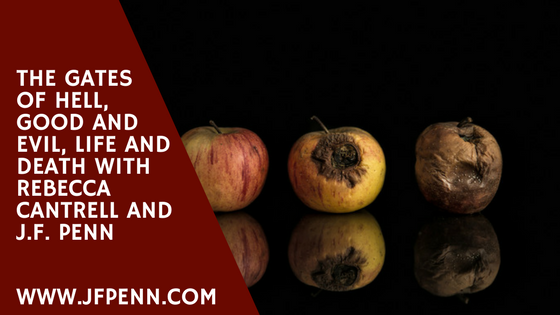 I walk around Europe seeing stories, and so does the fantastic Rebecca Cantrell!
I walk around Europe seeing stories, and so does the fantastic Rebecca Cantrell!
In this discussion, we talk about how we both use the Gates of Hell in our latest books and our themes of life and death, good and evil … and much more.
You can watch the video below or here on YouTube. You can also listen to the interview on Soundcloud and also read the transcript underneath the video below.
Watch the video
Listen to the audio
Read the transcription of the discussion between Rebecca Cantrell and J.F.Penn
Rebecca: Hi, I’m Rebecca Cantrell, the New York Times bestselling author of the Order of the Sanguines and Joe Tesla series. I’m here talking with J.F. Penn, New York Times bestselling author of the ARKANE thrillers.
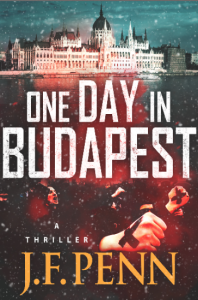
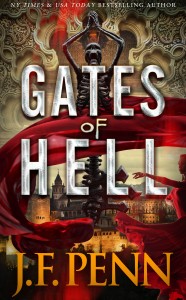
So, what drew you to take your characters straight to hell?
Joanna: Well, first of all, thanks for having me today, Becky, and I love your books, too. It’s so great to connect with you like this. It is also hilarious, don’t you think, that we’re both writing about the gates of hell, and we didn’t know, did we, until I put out my book, and you were like, “Oh, hey, our book’s about that, too,” which is kind of funny.
But for me, what’s so weird is actually just the other day, I found a diary from 2004. We’re recording this in 2015: I found this and I wasn’t even writing at the time—I was writing journals. I found a journal when I had traveled to Granada and Cordoba and these places in Spain, and I’d actually written, in those notes, the phrase, “The gates of hell,” from the Bible. So, I found this, and I didn’t have any idea that it had been that long in gestation when I found this in my diary.
“The Gates of Hell” is Book 6 in my ARKANE series, which is religious, supernatural thriller, and I started off by getting into Spanish Kabbalah, which is the Jewish mysticism. I started getting into Jewish demonology, and discovered the Devourers of God, which I love as a phrase: it’s awesome!
Rebecca: Yes, that is a wonderful concept.
Joanna: It is. And as I started to research Kabbalah and Spain, and started to use the Granada stuff, and Morgan Sierra, my character, is half Spanish Jew, half British Christian, so that kind of brings in her history. Obviously, I won’t go into the end of “The Gates of Hell,” although we have to get there, don’t we, at some point! But I think for me, I love the phrase, I think it’s a really evocative phrase, so I loved it as a title. But the book is really mainly about that Jewish mysticism, and the different places, so Safed in Israel, it opens at the Sagrada Familia in Barcelona, which you probably know—you travel a lot, don’t you.
Rebecca: I haven’t been there, but I’ve seen pictures online; I would love to go.
Joanna: It’s stunning. I went there with my husband and it is jaw-dropping. The most amazing modern cathedral you would ever see. It’s kind of like Tolkien as well, because it’s very natural. Gaudi didn’t believe in straight lines, so it’s all different shapes inside; the pillars are like trees. I really desperately had to have my opening scene at the Sagrada Familia, so that kind of sparked the book, really.
So, what about you and James Rollins? Where did your gates of hell come from?
Rebecca: Our novel series is also set in the Catholic world, and the idea that there are vampire priests that we call Sanguinists that subsist on the blood of Christ, so we were looking a lot into Biblical history and trying to figure out where that would end up. I think we knew pretty early on, even before we were done with the first book, that eventually we were going to end up at the gates of hell; we were going to have to deal with what that meant. And so we spent over 1,000 pages kind of getting to the gates of hell. I know for some people it’s easy, right: one little sin, straight to hell! Some of us have to write 1,500 pages to get to hell!
But it was really fascinating to study the mythology and the religious beliefs that are underpinning it, and we tried to kind of tie things back to that wherever we could; to work inside that kind of ritual. You’re a theologian, right, you have an actual degree in Theology, so I’m a hell amateur, but you’re like a hell professional. Did that help? Because obviously the gates of hell were haunting you for 11 years.
Did your theological background help you during the research and help you to prepare for it, or not?
Joanna: Yes, it’s funny. I do have a Masters in Theology from Oxford, I mean, it’s actually one of the oldest degrees in the world—which sounds amazing, but it does mean that the syllabus is still about 1,000 years old, as in, I was studying the Bible in Greek, Israel before the exile and Israel after the exile, and Early Church Patristics and all this type of stuff. Amazingly, it does underpin so much of our culture, and of course, you’re in Germany, I’m in London, our architecture, symbolism—you walk around western countries and you see the stuff out of this tradition, mythology, belief, whatever you want to call it.
So I think what I find in my writing is, even though when I left theology I became a management consultant, before I moved into writing, the ideas were planted for so much of my writing back then, because I studied it because I love this history so 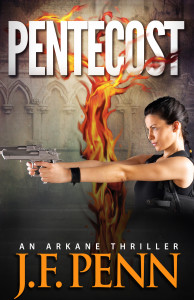
Rebecca: I was just like, “Oh, that’s so cool, I want a Jesus stone necklace!”
Joanna: Exactly! But then the stones, you have to find them by going around and finding the bodies of the Apostles. So this is Early Church martyrdom and where are the bones of the Apostles, and, as you know, of course, they are around the world, in churches, so you can go visit the bones of the Apostles, so why not have stones from the tomb of Christ? So the idea of where are the Apostles’ bones is from the original Early Church Patristics that I studies, Early Church Fathers, and I visited a lot of the places—probably 90% of what I write about, I’ve visited, and I love bringing my travels into everything.
So, really, for me, it’s funny: theology is an academic study of religion, and I think I carry on that study, as you do, and then what we do is, we kind of twist it, don’t we.
For example, you use the Sanguines’ transubstantiation. Do you want to explain that, for people who might not know?
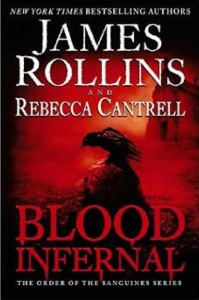
So, the idea from the books, the reason that was created, is because they were bringing a group of Strigoi, which is the vampires, into the Catholic Church, and the way for them to subsist would be on the blood of Christ, to let them be able to live without sinning. But, of course, it isn’t that simple: there’s a cost for that, there’s a price for that, and when they drink the blood of Christ, they’re not as strong, they don’t heal as fast, and it’s very painful for them, because they are damned creatures: their soul was taken from them when they became strigoi, and they can’t ever necessarily get that back. So there’s the idea that they have this, and they’re inside of this tradition, but it isn’t simple.
I think that one of the things that vampires have kind of moved away from, with “Twilight” and a lot of the newer vampires, is this idea that I thought, and then James thought as well, that it should have a cost. So, if you look at some vampiric traditions, it’s not all fun and games; there are real consequences to being a vampire, whereas if you look at some of the more modern ones, for example, “Twilight,” they can’t go out in the sun because they’re so beautiful, which is the opposite of they can’t go out in the sun because it burns them.
So if you look at the Cullen vampires, for example, there is no cost. They don’t have to kill people, because they can subsist on animal blood; they can go out whenever they want; and they’re eternally youthful, so there is no inherent conflict to their nature. And one of the things that we were working from was the idea of bringing that back to the foreground.
Joanna: Actually, there’s a new movie out, “Dracula Untold,” have you heard of this yet?
Rebecca: I have heard of it: it’s not coming out here for some time. But I definitely would like to see it. It’s supposed to be the background behind Dracula.
Joanna: And it’s about the cost; it’s about Vlad—we don’t want to go to the historical Vlad, because it’s quite horrible—but in the movie, in order to save his people, he must give up his life and his soul for his people. I find that—I’ve only watched the trailer, I haven’t watched it yet—but it’s like, I’m so much more compelled when there is a cost. I think for both your books with James, and with my books, and in fact with your historical series, as well, we know that there is always a cost. Both of us have body count: action scenes, fighting and a lot of dying, and I think that’s a really important part of writing thrillers.
I think one of the big things we tackle is good and evil, life and death. Would you say those are the themes of your work as well?
Rebecca: Yes, I think good and evil, life and death, light and darkness; this idea that in the real world, things are more complicated, and there is a cost to anything you do. Even if you’re doing things with the best intentions, in the best possible way you can, there’s still going to be a cost. I have the Hannah Vogel mysteries, that are set right before and during World War Two, and it’s a time where she can’t really ever win: the Nazis are going to come to power, World War Two is going to start, and she doesn’t necessarily know the future, but she knows that Germany is headed down a very dark path, and all she can do is kind of light the little bit and try to do good in the small world that she is in.
And I think that life is more like that than the pure kind of easy light ones. And those are more real to me: those are more real conflicts, where real people struggle with real problems, and have to make compromises.
Joanna: Again, both of us write particularly this action-packed, fast-paced books, certainly the Sanguines as well as my books, so you can read them at one level as the action thriller, but then you can—I hope—read them at another level and get some kind of message out of them.
Also, one of the things I love about writing is finding cool stuff to write about.
So, for example, in “Gates of Hell,” Gematria is this basically Jewish numerology and Torah letters each have a number. In Gematria, your name would in Hebrew would have a number, and then there are a whole load of other words that have the same number, so it’s really important that names and words can mean other words.
What we so brilliant in the book was, I had to find places in the world with the right Gematria to fit the clues, as I was doing it. I don’t know if you find this, too, but the synchronicity that often happens when you’re actually researching stuff-
You have an idea, you think, “I would like to write about this, but because it needs to be rooted in fact, I need to go find something real,” and then you find something real! Do you get that, too?
Rebecca: Yes, I’m always amazed at how, once you have idea of how something should be, and you start looking for information to back it up, it’s just there. We have the vampires, and then we also have angels, and there’s angelic forces in the second and third books, and so we wanted to start from the tradition of alchemy. We were researching alchemy and we stumbled across John Dee and Edward Kelly, and they were real historical characters that existed in medieval England, and also they traveled to Prague, which is where they were in the story.
And these were men—John Dee, in particular, was a scientist and a mathematician, and he wrote a lot of mathematical theories that are still used today in mathematics, but he was also interested in the occult, and he believed that he could talk to angels.
So, there was this guy, Edward Kelly, who—allegedly, or at least John Dee believed that Edward Kelly could talk to angels if he looked at this mirror that was made out of black obsidian and had come from the New World, and he could see the angels in there, and they spoke in a strange language called Enochian. And they transcribed this language, and it also was numerical-based, and through that then he could use his math to understand the language of the angels, and that was this man’s true goal in life.
And that was all very real, and Jim and I had talked about bringing all this stuff in, and then I just stumbled right on this real, historical character who had done every single thing that we would have needed him to do for the book, hundreds of years before we needed it! It was very strange. And that happens again and again.
Joanna: It’s funny you say that, because of course that mirror is in the British Museum, which is my research ground and in my London Psychic series, Blake works at the British Museum, in order that I can use all this stuff.
We just have the same brain, right, because my next book, “One Day in New York,” has Enochian on an artifact in the New York Met!
Rebecca: Wow! We have a bunch of Enochian passages.
Joanna: Maybe this is just the field we work in: we’re so fascinated but the same type of stuff. Anything with a religious or that arcane kind of edge, we’re immediately drawn to like little bees!
Rebecca: Although it is odd how we stumble across the same things. I think any writers do that, because there’s all this historical mystery, and then when you start looking at it, you have kind of the same brainwave: that is cool, there’s something there, that’s very, very cool, and then you go down the same kind of paths. And then you end up in different places, because you are different writers.
Joanna: Yes, we end up using the same ideas for different plots and different characters, and that’s why people like both types of books.
Rebecca: And then I think for the John Dee book, for example, when I was researching that, we wanted to open—and we do open—in an alchemy laboratory, and we had researched that online; I had found a painting of an alchemist’s lab that was painted at around the same time as the book. We wrote it with that, and I used a lot of details from that, and then I went to Prague, and there was an alchemy museum.
So, in Prague, there’s a place called the Speculum Alchemiae Museum …
and it turns out that in the 1500s, Prague was the center of alchemy for Europe, and there was an alchemists’ court by the castle, and then there was a secret tunnel that led under the river to this other small part of town, the Jewish section, and there was an alchemist’s lab underground there, that nobody knew about, but Rabbi Loew, a very famous alchemist, worked there. They blocked it up in the 1600s, nobody knew it existed, and then in 2008, there was a flood in Prague, the street collapsed, there was this giant hole, they followed the hole down, and they found this alchemy museum, completely intact. It had been there for 500 years.
And so, I got to go to Prague and tour it, and they’d cleaned out all the mud and all the river, and you could see the original big, giant flasks that they used for distilling things; you could see the room where they had tried to make the Philosopher’s Stone; you could see their furnaces
… and they actually had a glass bottle that contained the Elixir of Eternal Youth
… brewed by Rabbi Loew himself, that he had stuck in the wall behind this fresco.
Joanna: I hope you’re going to say you drank it!
Rebecca: No, they wouldn’t let me do it, but they did let me hold it! I pulled out the novelist card: “I’m a novelist, and I’m writing a book,” and they said, “You have a go,” and I went, “Oh, what if I drop it? What if I drop the 600-year-old Elixir of Eternal Youth?” And Rabbi Loew had also left, in Latin, directions for how to brew it, and you can buy it online through the museum website, and there’s a group of monks in Brno, in the Czech Republic, that brew the Elixir of Eternal Youth. And it has like 170 different herbs and they have to be collected by moonlight, at certain phases of the Moon: it’s this incredibly complex thing.
Joanna: That’s amazing. You’ll like this, then. My gates of hell has a Golem in it!
Rebecca: Ooh, how cool!
Joanna: Same guy, right, Rabbi Loew.
Rebecca: Same guy. In fact, at that museum, there was a bookcase, and the bookcase slides across and you go down the steps to the alchemy museum. We were walking down, and there’s this big iron ring in the wall. I said, “What is that for?” and I was assuming it was something like dogs, and the woman looks at me and she’s like, “That’s where Rabbi Loew used to chain up the Golem.” And then she just walks right down the stairs! My husband and my son are following: I was just standing there staring at that iron ring, completely transfixed by the idea.
So, when he was bad, apparently, Rabbi Loew would chain him at the top of the stairs, and he would have to sit there, at the top of the stairs, I guess on like Golem time out!
Joanna: And then he got a bit out of control, didn’t he, so then he had to kind of melt him down. But that’s cool. This is what’s so fun about talking to you: you don’t meet many people who get so excited about the same things that we do! We’re just like, “Hey, look at this cool place”.
I think we’re very lucky to live in Europe, too, because we could write about every square mile of where we live.
Rebecca: Yes, everything is here: there’s so much history here to write about. And yes, it’s really cool talking to people who get excited about the stuff.
Once I wrote a vampire book called, “I, Dracula,” and a friend of mine who’s a medical examiner for Manhattan wrote me an autopsy for the vampire’s victim. It was an official autopsy: all of the language, all of it, and I got it at as I was in Starbucks one day, and so I’m in line with my husband, and he’s ordering whatever, and I’m like, “Oh, my god, my autopsies are here!” Dear silence in the entire restaurant. And I’m like, “Look at that, it says the spleen is unusually pale.” And my husband’s like, “Honey! Can we talk about this outside?”
Joanna: Yes, or when we’re walking around London and I’m like, “That would make a great murder weapon!”
Rebecca: Yes, that makes people nervous!
Joanna: It does.
Rebecca: “If you were going to kill someone here, how would you do it?”
So what is the coolest kind of research that you did for “The Gates of Hell,” something that was completely unexpected?
For me, it would have been that museum in Prague. Did you stumble across something like that? Not counting the Sagrada Familia.
Joanna: Yes, I think probably—I’m a Scuba diver, I’m actually a Dive master, I’ve done a lot of Scuba diving, I love Scuba diving, and of course all thriller characters can Scuba dive, because, you know, they’re action people. For “The Gates of Hell,” again, this is one of those funny things: one of the Gematria—and I was finding the clues as I was going through, so I’m in Safed in Israel, which is the center of Kabbalah, and I was kind of stuck, I was, “How do I get from here to the gates of hell?” because if you do your research, as you have, the gates of hell are not in Safed. There are a number of places in the world where they could be, but they’re not there.
Anyway, I did some Gematria on the various things I was doing, and I don’t want to give too much away—I end up at the Dead Sea.
Rebecca: That must have been so salty: you must have had to have a lot of weight to dive.
Joanna: Well, exactly. What I wanted to do was go look for Sodom and Gomorrah-
Rebecca: As one does!
Joanna: As one does! And of course, they have done various research in there, and there are some people who say that the remains of Sodom and Gomorrah are at the bottom of the Dead Sea, and there’s actually the Hills of Sodom around that area, the Southern part of the Dead Sea. So, then I was like, “Oh, I really want to Scuba dive on the remains of Sodom and Gomorrah.” And then I found that you can actually Scuba dive in the Dead Sea. And I found a video on YouTube of diving down there.
Now, I wouldn’t recommend it to anyone, because it’s so salty—you have to wear a full face mask, rather than just a reg and stuff—if you get that water in your throat, you immediately asphyxiate. Because it’s so salty, you will die immediately! And you have to wear massive amounts of weights, so it’s very dangerous, and only extreme sort of divers. And also it’s really not a great dive, because there’s not much down there; it’s not like the Red Sea, with loads of fish.
So, I think it was pretty amazing to find a video of Scuba diving under the Dead Sea in the salt. I mean, that’s awesome. Do you do a lot of research on YouTube?
Rebecca: I do, because there’s so much there now. For example, for the Hannah Vogel books, where you wouldn’t think 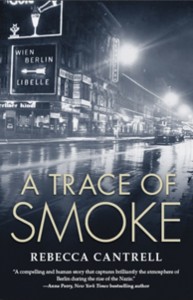
And then, for the Joe Tesla series, which is set in the subways underneath New York, there are a whole bunch of urban explorers who go down in the subways under New York; they sneak in through various manholes and off of the platforms, and they film it. So they go to the deserted stations, and they go down steam tunnels, and they crawl around sewers, and all of that stuff is on YouTube, so you can go all these places. If they catch you, I imagine you get arrested or fined or something—I would not necessarily want to spend two or three hours crawling through a sewer in New York, but I’m totally happy to watch somebody do it on YouTube!
Joanna: I think we watch the same movies, because in my “One Day in New York,” I needed to get from one place to another, so I did the same thing. Go into the tunnels. Is it called Undercity? The guy who does this stuff?
Rebecca: Yes, there’s a guy who sneaks in, you can buy a tour with him, and then he’ll sneak you in to various places. Yes, that’s the same guy. So, yes, it’s amazing what’s available on YouTube, and that makes such a difference, because there are places that I won’t necessarily ever get. I will probably never crawl around a sewer under New York city, although I would love to go see the abandoned stations.
Like, City Hall station is an abandoned station: it’s a beautiful, decorated station that only ran for 40 years, and then it was closed down because the tracks have a bend in them and the trains couldn’t use them at the full speed, or something like that. But that’s unusual. I would love to run around and see that. London has a bunch of stations like that as well.
Joanna: Yes, and in fact this is another similar theme. My book, “Prophecy,” is all about catacombs, the Paris bone catacombs, the Palermo mummies, the Capuchin crypt in Palermo with all the mummies. Like you said about Prague, a lot of 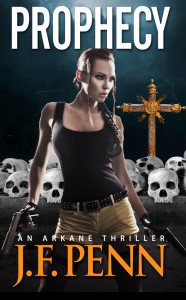
I love catacombs!
Rebecca: It’s definitely true. I know when I was writing with Jim, the first book, there was so much underground stuff, crawling in the subway, going in all these tunnels and stuff, and so the second book, I decided we were going to have a new theme: “We’re going to call it the water book, and then the third book will be the air book, everybody’s going to be outside. We’re going to go outside.” He was like, “OK, we can do that.” And then as soon as I wrapped up the book, I started my own series, the Joe Tesla book, which is set entirely in the tunnels underneath New York City. And Jim has not stopped giving me grief about it ever since then! He uses every opportunity to point out that I told him we couldn’t live in the tunnels all the time, and the very next thing I did was set up a whole tunnel book.
But there is something to be said—and I’ll give him credit for that, too—for the things that are hidden underground, the things that we can’t see, and those are places where you can go and see those things. And anything could be under there.
If you dig deep enough under Paris or Berlin, or any old city in Europe, you could find amazing secrets.
Joanna: Oh yes, and we like finding those. Of course, both of us are attracted to archeologists. Certain, for me, Morgan Sierra is kind of a female Indiana Jones slash Lara Croft kind of figure, and finding these ancient things is part of our brand, I think. Of course, you’re a historian: your Hannah Vogel books are based in a different time.
Rebecca: Yes, for those books, I didn’t go off the rails so much! The Hannah Vogel books are very historically accurate, and if I do deviate from the real historical world, then I say so in my author notes. Whereas obviously, the strigoi books are.
Joanna: This is another question I’ve been pondering about fantasy: whether the books are fantasy. Mine is the gates of hell, and there are, like I mentioned, the Golem. There’s various supernatural elements. I mean, you have the Strigoi, who are vampire priests. Are we thriller writers, and a lot of the stuff we write is based on fact, probably 90% of what I write is fact, and then I just twist it, and I think that’s the same for you and Jim.
So, do you ever call yourself a fantasy writer or dark fantasy? I’m starting to call myself dark fantasy a bit as well as thriller.
Rebecca: No, but we do call them gothic thrillers, which I think brings in the idea of this supernatural gothic world. For me, I feel like fantasy books are not at all based in reality, so those are things like “Lord of the Rings” that are based in a completely different reality than the one we have, whereas my book does have some overlap. I know we don’t have vampires and they’re not real, obviously-
Joanna: They’re not real, Becky!
Rebecca: Oh, man! But I do think that there’s more overlap, whereas the pure fantasy things, for me, are like “Lord of the Rings” or the “Chronicles of Narnia,” where you go into a world that really isn’t like the world here.
Joanna: Yes. Good.
Rebecca: But I could be completely wrong.
You also write another series that’s both more and less reality based, I would say: the London Psychic series. Do you want to tell me about those? I’ve read one: I really loved it.
Joanna: Oh, thank you. What happened was, again, doing research, or just experiencing London, I went to the Hunterian Museum, which is a medical specimen museum in the London College of Surgeons.
Rebecca: We have one of those here, too! The Charite Museum—same thing!

Rebecca: I mean, if there’s enough money in it, of course people have done it.
Joanna: Yes, they’ll do that. Anyway, I went to this medical specimen museum, and I was really viscerally, my stomach was clenching—I was disturbed by this place. When you get a physical reaction to a place, to me, that means I have to write about it. This has to go in a book. You have to visit this place. It’s got these massive glass cabinets, multi-shelved, all with these bottles: it’s amazing. And then, right in the middle, there’s this kind of open space. So, of course, I had to open the book with a body in the Hunterian.
Then it was a question of who is the body and what happens next?
I had originally wanted to write just a straight crime novel, but I’ve discovered that I can’t write anything that doesn’t have a supernatural element! So, what I ended up having was a character from the British Museum round the corner, Blake, who’s half-Swedish, half-Nigerian, so he’s a mixed race character, which is very common in London, and Berlin, obviously: it’s kind of mixed-race. He’s a psychic, and he reads objects. So, when he picks up an object, he can read the history. And this book, “Desecration,” then goes into the history of the anatomists and people like Mengele at Auschwitz, and kind of ties into that experimentation that we’ve done on both live bodies and dead bodies.
[You can watch a video on the research for Desecration here.]
And then I got into body modification, and the things that people are doing to themselves when they’re alive.
Rebecca: On purpose, yes.
Joanna: On purpose, like splitting tongues and implants. There’s an exhibition in New York called The Bodies Exhibition, which is plastinated corpses!
Rebecca: That’s a bit far for me!
Joanna: But it’s amazing, because they’re kind of dissected, and you can see inside, and it’s an amazing technology. All of these things came together, and it’s essentially a murder mystery series with a British detective and a psychic kind of sidekick, and a bit of romantic tension, so it’s got a standard murder mystery level, but it’s also got this kind of deeper level of all the interesting stuff that I find in London.
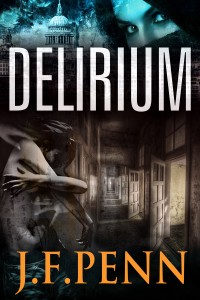
Rebecca: I think the ability to find cool stuff, for me, is one of my favorite parts about being a writer. I get to pore over everything, find things that I think are cool, and then put them together with crazy voices in my head and write it down, and that’s my job! And it lets me go all these places and learn all these things that are for me absolutely fascinating, and I think that, for me, is the best part of being a writer. What about for you?
What’s your favorite part about being a writer?
Joanna: I think it’s probably the same thing. I think you and I both share this need—I think it’s a need—to actually go to places. There are writers who don’t, who do all their research on the Internet, but I love doing this. We went to Budapest when I wrote “One Day in Budapest”: we spent four days—my husband said, “This is very romantic,” when I took him to the Torture Museum, and then the mass grave at the Synagogue! But then we went shooting in a Soviet bunker, which he really enjoyed. But I love, like you, the immediacy of actually going somewhere, and you find things that you probably wouldn’t find if you were just researching. Maybe it doesn’t impact the story that much, but it adds that flavor for us, that kind of experience.
I do think there’s a color that comes from actually visiting the place; there’s the opening scene in the Sagrada Familia, I think my own reactions to the things that I saw there, the things that I picked out in the church to use as my scene: those are from my personal experiences. Plus I can share my photos with my audience, and I do a Pinterest board for every book, so people can go and look on Pinterest and see all the things that went into the book, which is really cool. I think we’re quite similar in that way: we like doing these travels.
Rebecca: It is fascinating, and there’s something about the sense of it, there’s something about actually holding the Elixir of Eternal Life in your hand, and knowing that—it was actually in a glass case, it was the glass case—still, I was this close to something that was brewed and touched by Rabbi Loew, who was a famous alchemist who created—allegedly—the Golem. And to think that I’m holding that: it’s just a wonderful, powerful connection to history, and I think that’s one of the best parts about it.
Joanna: I think maybe at some point we should organize some sort of travel trip for people who want to come with us to these cool places!
Rebecca: People who want to go and see the supernatural and be terrified! I mean, there are tours like that: there’s the Ripper Tour of London, which I didn’t go on, because I was traveling with my younger son, but I definitely think there’s an appetite for that. People did want to go on this Ripper Tour of London, where you went to the places where Jack the Ripper had been, and learned historical facts about those events. And there’s Golem tours of Prague, of course.
Joanna: It’s great. I’ve been to Israel 11 times, so a lot of that comes into my books. In the ARKANE series, I think six out of seven have some kind of Israel scene in. But it’s funny, I haven’t actually been for a while, it’s been a long time. My husband’s Jewish, and he’s never been, so I’m like, “I really need to get back to Israel and see how it’s changed.”
One of the places that I really want to write about there is Megiddo, which of course is the historical site of Armageddon.
Now they’ve done an archeological dig: it’s 13 cities that have been razed. That’s why it’s Armageddon: because it’s right in the center of the Golden Crescent, everybody came through Megiddo, so it just got destroyed, over and over again. It’s an amazing place, and I definitely want to write something there.
Rebecca: So, is that your next research trip?
Joanna: Oh, goodness. Well, actually, I’m speaking in America, in Charleston; I’m going down to Savannah in Georgia, and I feel like I will be writing something about Savannah, because I first read about it in “Midnight in the Garden of Good and Evil,” years ago, 15 years maybe, that book has been out, and since then, Savannah has always had that kind of romantic image in my head, so I definitely think there’s going to be something that comes out of Savannah.
Rebecca: Good!
Joanna: And what about you? What’s your next book?
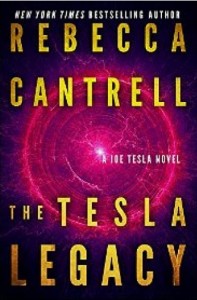
Joanna: Oh dear.
Rebecca: And yet he was this brilliant, brilliant man who really set the stage for a lot of the modern world. So you have this interesting character. I can’t believe there’s not been a Hollywood movie about him yet.
He’s shown up in side movies, but there’s never been a real—I’ve seen documentaries, but I’ve never seen a real big Hollywood Nikola Tesla movie. He had a little bit in The Prestige.
Joanna: I was going to say, The Prestige is the one that comes to mind.
Rebecca: And the idea of ball lightning, and just being able to hold lightning in his hands—and he did; he shot lightning miles, and we still can’t do what he did. So this book opens up with the Earthquake Machine, which is a machine that—allegedly—he invented that when you set to the resonance so that it vibrates at the same frequency as an object, can destroy that object. He said that he could knock down the Empire State Building with five pounds of air pressure, and if the resonance were applied at the proper parts of Earth, he could split the Earth in the two. This was in the New York Times in the 30s, and all this other stuff. He allegedly created this device and created an earthquake in Manhattan, and the police came—and that is such a great Nikola Tesla moment. There was an earthquake in Manhattan that he’s created with his device, and the police immediately come to his lab, because if there’s some crazy thing going on, that’s where you go!
Joanna: Again, that’s really funny, because I just interviewed Scott Mariani—do you know Scott’s books? His latest book is about the Tesla Machine!
We’ve all got the same minds, haven’t we—we’re just so fascinated with similar stuff. It’s awesome!
Rebecca: I think there’s stuff that’s in the air; there’s certain moments where it comes down and everybody who’s thinking along those lines has their moment to interact with it. So that’s the next one: “The Tesla Legacy” comes out February 5th, 2015. How about you?
What’s next for you?
Joanna: Well, “Gates of Hell” only just came out, so I’m quite happy with that. “One Day in New York” will be the next book that comes out, and there’s something buried under New York, basically, that keeps New York from being destroyed, that’s the kind of hook on that one. There’s a secret underneath, so we get into that. And then the next one will be “Deviance” in the London Psychic series.
And again, I was just thinking of the underground thing, because I also want to get under Edinburgh. Have you done under Edinburgh?
Rebecca: No, I haven’t.
Joanna: Oh, there’s some serious ghost tours under Edinburgh, because of course there were places that were bricked up and people were just left to die with the Plague. There’s some really horrible stuff under Edinburgh. I’d actually really like to write something up there. I think the other thing is, we’ve got to remember to research more locally, rather than always going, “Yes, I must get to Israel and Iran.” I really would love to do a trip to Iran, because there’s some amazing stuff in Iran historically, but a little more difficult to travel there. I’m in London, but also Edinburgh’s only just up the road, so I think I’m going to try to do a bit more local stuff as well as the far-off lands!
Rebecca: See, I seem to favor that. I wrote all my Berlin books before I moved here, and now that I’m here, I haven’t written a single book sent in Berlin, so I clearly cannot do local research.
Joanna: You’re right, because of course now Joe Tesla’s in New York.
Rebecca: Joe Tesla’s in New York and I’m in Berlin, so I think I have to move to New York to write stuff set in Berlin. I wrote the first Berlin books when I was in Hawaii, so you never know. And there’s a lot of fascinating stuff there, as well.
Joanna: I think everywhere, once you actually get into it. You mention that: I want to write one in New Zealand. I was in New Zealand over Christmas, and there’s a lot of Maori gods around the volcanoes, and the Polynesian volcanic gods, and I’m thinking, well, what happens if there’s a big volcanic eruption in New Zealand and these gods emerge from the island, take their island back? I’m like, “OK, but that’s an entirely different thing.” We have so many ideas, don’t we. I mean, this is our life: it’s very exciting!
Rebecca: It is a lot of fun. So many ideas, but not quite enough time. New Zealand is so beautiful and so diverse and there’s just so much going on there.
Joanna: There is, definitely.
Rebecca: So, I have one more question, and that is—I hate this question, so don’t give it back to me, I get this almost every time I do an interview.
Who is your favorite author?
Joanna: It’s a very tough one. I would say probably my favorite book is “The Stand” by Stephen King. To me, it’s my gold standard of good versus evil, light versus dark, the kind of epic struggle, the supernatural angle. It probably is considered post-apocalyptic, because it’s after a plague, but to me, that’s not what I remember. I don’t remember it is a post-apocalyptic book; I remember it as this kind of good versus evil and this evil character. So that’s kind of my gold standard, and the book that I really come back to over and over again, and my aim is to write something that’s as memorable as “The Stand.”
I think they’re going to try and make it into a movie again, like many of King’s books they’ve not made good movies of, or have failed, but they’re going to try again with “The Stand,” which makes me think that there is this desire for more supernatural things, that both you and I write, so that’s good.
And then I’ve got to add—I think I told you this—the reason I started following you is because you co-wrote with James Rollins, who is one of my favorite authors. And probably one of the reasons I write the ARKANE series—ARKANE is a secret agency under Trafalgar Square in London, and it’s a series—and because of the Sigma series, I was like, “I want to do what James Rollins does, which is have an organization where I can have a whole series that will keep going, that I don’t have to come up with new characters, I just have to put them in a different situation.” So the Sigma series is kind of my model for ARKANE, and also I used to love—well, I still love—reading Rollins, but before I started writing, he is still—he and you, because I have the hardbacks—the only author I buy in hardback.
Rebecca: Wow.
Joanna: So I have yours and James’s book in hardback. Of course then I discovered your other books, and this is so much the world—you discover authors because of authors you already know. And then I discovered you and Joe Tesla, which is award-winning as well as bestselling! Amazing. So there you go.
And if I’m not allowed to throw that back at you, the question I’m throwing back at you is:
Show us those gloves!
Rebecca: My sister made me these. These are my Bam-Pow. So I’ve got to Bam-Pow! She knitted them for me for Christmas, because when I write in cafes in Berlin, they don’t heat them adequately, and so I’m usually there, I have on my sweatshirt and my sweater and all my stuff, and my hands get cold. These don’t have any fingers, and I can type with them, so they’re my Bam-Pow! And when I get mad, or I’m writing an action scene, I just say, “I’m gonna go Bam-Pow!” and for some reason, I find that endlessly amusing!
Joanna: Tell your sister that there is a market for those gloves.
Rebecca: The thing is, she only knits a few, and then she gets bored. So you have to catch her early on, before she’s done with them. I think I got a blue pair, and then I got one is green and one is red two Christmases ago. I’ve been begging for them, and it took her like two years to finally do these for me. I can tell her.
Joanna: Those are brilliant.
Rebecca: I know, aren’t they cool! They keep your hands warm, and they’re just wonderful. Bam-Pow! See!
Rebecca: So, where can we find you and your books online?
Joanna: My books are ebook, print book and audio book; they’re available on all the online stores, Amazon and Nook and all the usual places and also at JFPenn.com –and you?
Rebecca: My books are also available everywhere that fine books are sold! They’re in bookstores and Amazon and Kobo and iBooks and all those places. And then my website is rebeccacantrell.com –and on there, I don't sell my books, but I have information about the background of the books, I occasionally do blog posts about research trips or the story behind the story of what I’ve been working on.
Well, thank you for talking to me today: this was wonderful, I had a great time.
Joanna: Yes, it was super-fun! Thanks so much, Becky!
